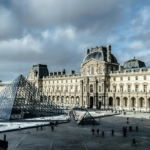Paris Historical Sites: A Journey Through Time
Exploring Paris historical sites is akin to stepping into a living museum, where each landmark and hidden gem tells a tale of the city’s rich heritage. From stunning architecture to poignant memorials, Paris is filled with historical treasures that reflect its past, blending the new with fragments of history. In this guide, we’ll uncover the most significant Paris historical sites and encourage you to explore this magnificent city’s narrative threads.
The Heart of Paris: Île de la Cité
Notre-Dame Cathedral
One of the most iconic Paris historical sites, Notre-Dame Cathedral reigns supreme on the Île de la Cité. This Gothic masterpiece, with its majestic towers and intricate façades, has stood for over 800 years. Although it suffered a devastating fire in 2019, restoration efforts are underway to return it to its former glory. A visit to Notre-Dame offers insight into the historical and architectural significance that has made it a UNESCO World Heritage Site.
Sainte-Chapelle
Just a short walk from Notre-Dame, Sainte-Chapelle showcases the stunning beauty of Gothic architecture. Completed in 1248, this chapel is famous for its breathtaking stained-glass windows depicting biblical scenes. Sainte-Chapelle serves as a remarkable illustration of the craftsmanship and artistry of its time, making it one of the must-see Paris historical sites for art lovers and history aficionados alike.
The Royal Legacy: The Louvre Museum
The Louvre History
Originally a fortress built in the late 12th century, the Louvre has undergone multiple transformations. It became a royal palace and eventually evolved into one of the world's most famous museums. Its vast collection bridges centuries and cultures, making it a central point for studying Paris's artistic and historical evolution. The transition from royal residence to museum further underscores the layers of the city’s past.
Iconic Artworks
Within the Louvre, you will find masterpieces that have shaped art history, including the Mona Lisa and the Venus de Milo. Engaging with these renowned artworks is not just a visual experience; it offers a historical narrative that encapsulates the artistic movements that flourished in France and beyond.
Monuments of Revolution: Place de la Bastille
The Bastille Prison
The storming of the Bastille on July 14, 1789, marked a pivotal moment in the French Revolution, symbolizing the fight against tyranny. Although the original prison was destroyed, the Place de la Bastille now celebrates this historic event. Visitors can see the July Column, which commemorates the July Revolution of 1830, making it a significant site that opens discussions about liberty and democracy.
The Surrounding Area
Today, the area around Place de la Bastille is vibrant, with cafés and shops that reflect the revolutionary spirit of the past, blending history with contemporary Parisian life.
Artistic Inspirations: Montmartre and Sacré-Cœur
The History of Montmartre
Once a quaint village outside of Paris, Montmartre became a hub for artists in the late 19th and early 20th centuries. The area's bohemian culture attracted luminaries like Picasso and Van Gogh, forging a deep connection between art and the social movements of the time. Walking through its streets is like wandering through an open-air gallery, rich with history.
Sacré-Cœur Basilica
Atop the highest point in the city, the Basilica of Sacré-Cœur offers a stunning panoramic view of Paris. Completed in 1914, its Romanesque-Byzantine architecture stands as a symbol of hope and faith. The basilica’s serene interior and majestic dome make it an essential stop for those interested in both the religious and artistic history of Paris.
Hidden Gems: The Catacombs of Paris
The History Behind the Catacombs
Beneath the streets of Paris lie the Catacombs, a hauntingly beautiful network of tunnels. In the late 18th century, the city faced a cemetery crisis, leading to the transfer of bones from the overflowing cemeteries into these underground quarries. Today, the Catacombs serve as a chilling reminder of Paris's historical challenges and a fascinating exploration of its macabre past.
Visitor Experience
Visitors can walk through the dimly lit corridors, viewing the neatly stacked skulls and bones that tell the story of Paris's population from centuries past. This experience provides a unique connection to the city’s history and its ongoing relationship with life and death.
Architectural Marvels: Palais Garnier
An Overview of Palais Garnier
The Palais Garnier, also known as the Opéra Garnier, is a stunning architectural feat built between 1861 and 1875. This opera house exemplifies the grandeur of the Second Empire style, with its opulent interiors, grand staircase, and striking ceiling painted by Marc Chagall. It holds a significant place in the cultural and historical landscape of Paris.
Cultural Significance
The Palais Garnier has hosted numerous performances and events throughout its history, contributing to the artistic and cultural development of France. Today, it remains a vital venue for opera and ballet, making it a key part of Paris historical sites that showcase the country’s artistic heritage.
The City of Light: The Eiffel Tower
The History of the Eiffel Tower
Constructed for the 1889 Exposition Universelle to celebrate the 100th anniversary of the French Revolution, the Eiffel Tower was initially met with mixed reviews. Over time, it has become a symbol of Paris and a marvel of engineering. Standing at 1,083 feet tall, it was the tallest man-made structure in the world until the completion of the Chrysler Building in New York.
Visitor Experience
Today, visitors flock to the Eiffel Tower to enjoy breathtaking views of Paris. Its three levels offer perspectives of the city’s historic layout, connecting the past with the modern era. The surrounding Champ de Mars provides a picturesque setting for those wishing to enjoy the tower from the ground level.
The Literary Boulevard: Rue de la Sorbonne and the Latin Quarter
Center of Learning
The Latin Quarter is one of the most historic neighborhoods in Paris, home to the prestigious Sorbonne University. This area has been a center of knowledge and intellectual discourse for centuries, drawing scholars, writers, and revolutionaries. Walking through its cobblestoned streets provides a glimpse into the scholarly history that shaped French thought.
Cultural Landmarks
In addition to the Sorbonne, the Latin Quarter is lined with quaint bookstores, cafés, and historic sites such as the Panthéon, where many of France's great thinkers and writers are interred. These establishments make this neighborhood a must-visit for those interested in the interplay between culture and history in Paris.
Conclusion: Your Path Through History
Paris historical sites offer an endless array of experiences that allow visitors to connect with the city’s rich past. From monumental structures to hidden treasures, each location weaves together the complex narrative of France’s capital. As you explore these landmarks, take a moment to reflect on the stories they hold and the people who shaped the city into what it is today.
FAQ Section
What are some must-see Paris historical sites?
Some must-see Paris historical sites include Notre-Dame Cathedral, the Louvre Museum, and the Eiffel Tower. Each location has its unique history and significance within the broader context of Paris.
Why is Notre-Dame Cathedral important among Paris historical sites?
Notre-Dame Cathedral is important as a masterpiece of Gothic architecture and a symbol of the city’s cultural and historical identity. Its resilience through years of history makes it one of the most revered Paris historical sites.
How do the Catacombs of Paris contribute to the understanding of the city’s history?
The Catacombs of Paris showcase the city’s historical challenges, particularly regarding population and burial practices, offering a stark but insightful perspective on life and death in Paris over the centuries.
Is Montmartre considered a significant historical site in Paris?
Yes, Montmartre is significant due to its rich artistic legacy and as a former village that hosted many famous artists. It provides a unique historical viewpoint that has greatly influenced French culture.
How can I explore the history of Paris beyond the famous landmarks?
To explore Paris historical sites beyond the famous landmarks, consider visiting lesser-known locations such as the Musée Carnavalet, dedicated to the history of Paris, or wandering through the hidden passages and courtyard gardens that reveal the city’s layered past. For more information, you can visit Musée Carnavalet.



